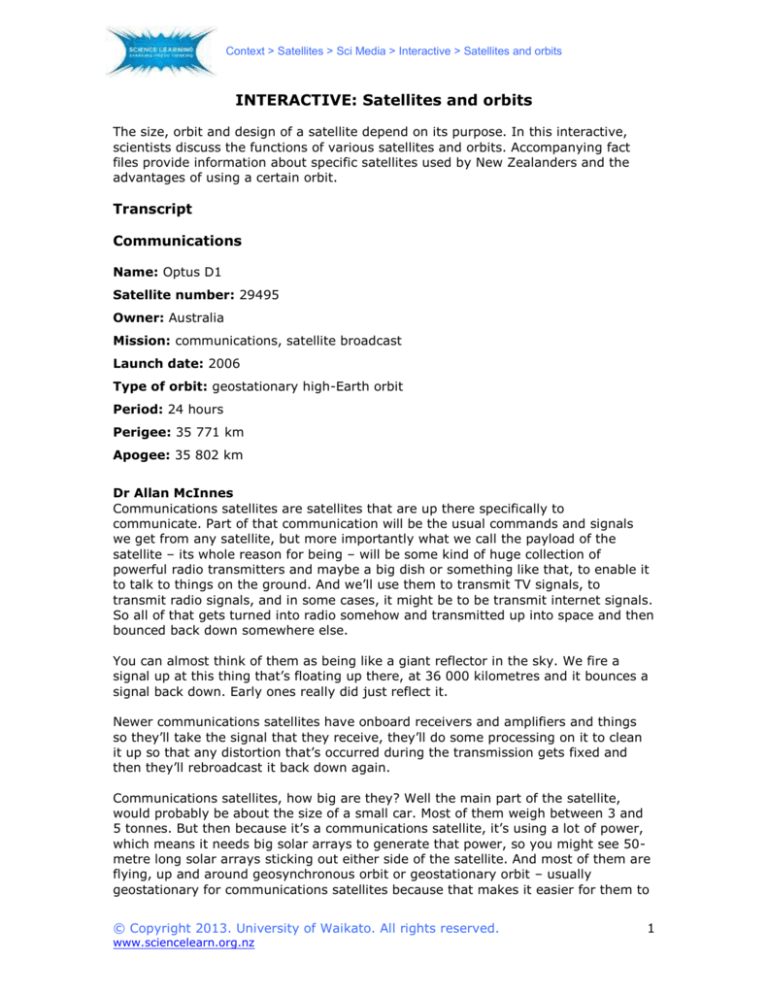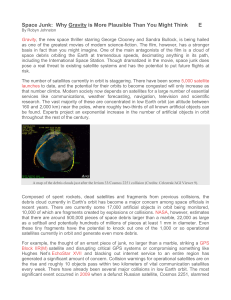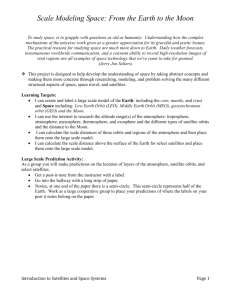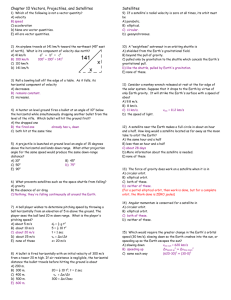
Context > Satellites > Sci Media > Interactive > Satellites and orbits
INTERACTIVE: Satellites and orbits
The size, orbit and design of a satellite depend on its purpose. In this interactive,
scientists discuss the functions of various satellites and orbits. Accompanying fact
files provide information about specific satellites used by New Zealanders and the
advantages of using a certain orbit.
Transcript
Communications
Name: Optus D1
Satellite number: 29495
Owner: Australia
Mission: communications, satellite broadcast
Launch date: 2006
Type of orbit: geostationary high-Earth orbit
Period: 24 hours
Perigee: 35 771 km
Apogee: 35 802 km
Dr Allan McInnes
Communications satellites are satellites that are up there specifically to
communicate. Part of that communication will be the usual commands and signals
we get from any satellite, but more importantly what we call the payload of the
satellite – its whole reason for being – will be some kind of huge collection of
powerful radio transmitters and maybe a big dish or something like that, to enable it
to talk to things on the ground. And we’ll use them to transmit TV signals, to
transmit radio signals, and in some cases, it might be to be transmit internet signals.
So all of that gets turned into radio somehow and transmitted up into space and then
bounced back down somewhere else.
You can almost think of them as being like a giant reflector in the sky. We fire a
signal up at this thing that’s floating up there, at 36 000 kilometres and it bounces a
signal back down. Early ones really did just reflect it.
Newer communications satellites have onboard receivers and amplifiers and things
so they’ll take the signal that they receive, they’ll do some processing on it to clean
it up so that any distortion that’s occurred during the transmission gets fixed and
then they’ll rebroadcast it back down again.
Communications satellites, how big are they? Well the main part of the satellite,
would probably be about the size of a small car. Most of them weigh between 3 and
5 tonnes. But then because it’s a communications satellite, it’s using a lot of power,
which means it needs big solar arrays to generate that power, so you might see 50metre long solar arrays sticking out either side of the satellite. And most of them are
flying, up and around geosynchronous orbit or geostationary orbit – usually
geostationary for communications satellites because that makes it easier for them to
© Copyright 2013. University of Waikato. All rights reserved.
www.sciencelearn.org.nz
1
Context > Satellites > Sci Media > Interactive > Satellites and orbits
talk to things on the ground. That means they also to need to produce huge amounts
of power because they’re a long way away and they need the radio transmissions to
go a long way.
Weather
Name: MTSAT-2 (Multi-functional Transport Satellite)
Satellite number: 28937
Owner: Japan
Mission: Earth science, weather, communications, navigation
Launch date: 2006
Type of orbit: geostationary high-Earth orbit
Period: 24 hours
Perigee: 35 777 km
Apogee: 35 797 km
Dr Allan McInnes
Weather satellites are, I guess, one of the earliest applications of satellites after
communications. The very first satellites were communications satellites. Weather
came along afterwards when people said, “Hey, it would be really great if we were a
long way above the Earth and could see a lot of it and could see weather patterns
developing.”
So weather satellites will be – usually they’re a little bit smaller than a
communications satellite, maybe 3, 4 metres on its side, 3 tonnes something like
that. Typically what they’re going to be doing is carrying a payload of visible and
infrared sensors – so basically cameras that are looking at the Earth either seeing
visible light – the stuff that you and I see on a day-to-day basis – or infrared, which
lets them see how the temperature of clouds and the ocean and the air is changing,
and obviously those temperatures have some effect on how weathers can develop.
Then that information will go to meteorologists on the ground who can figure out by
looking at the data what the weather’s going to do or at least where the clouds are.
GPS
Name: Navstar 66
Satellite number: 37753
Owner: USA
Mission: Navigation
Launch date: 2011
Type of orbit: medium-Earth orbit
Period: 12 hours
Perigee: 20 148 km
Apogee: 20 217 km
© Copyright 2013. University of Waikato. All rights reserved.
www.sciencelearn.org.nz
2
Context > Satellites > Sci Media > Interactive > Satellites and orbits
Dr Allan McInnes
GPS navigation satellites are in a medium-Earth orbit at about 20 000 kilometres
altitude above the Earth. It’s specially designed to enable GPS satellites to see a lot
of the Earth all at one time without having to build lots and lots of satellites.
These GPS satellites, is basically just broadcast a special radio signal to the Earth.
It’s what’s called a navigation signal and it carries information about the time at
which it was transmitted and which satellite it came from and things of that nature.
What happens is that your GPS receiver on the ground receives that signal, not just
from one satellite but from several of them and can use that information along with
information about what orbits the satellites are in to figure out how far away it is
from each satellite.
And once it knows how far it is from each satellite, if it’s got more than one
measurement – in fact you need at least four to get a good fix – it can figure out
where on the Earth it is. And that’s essentially how GPS works, is by measuring the
distance to several different GPS satellites and saying OK, well the only place that
could be that distance from all of these satellites is this place right here.
Hubble
Name: Hubble Space Telescope
Organisation: NASA, European Space Agency
Mission: telescope free of interference from Earth’s atmosphere
Launch date: 1990
Type of orbit: near-circular low-Earth orbit
Period: 96–97 minutes
Perigee: 561 km
Apogee: 566 km
Dr Allan McInnes
How high up is the Hubble Space Telescope? It is 560 kilometres altitude – so it’s in
a low-Earth orbit – partly it’s there because it was easy to get to with the Space
Shuttle. Hubble Space Telescope is designed to study the universe; it’s a telescope
that was put in space so it was above the atmosphere.
If you’re on the ground trying to look at space and there’s a lot of air in the way and
it makes it harder to see what’s going on, it’s like trying to look through fog
essentially, but maybe not quite as thick. So if we put a telescope up in space, we
get a much clearer view, and Hubble’s returned some fantastic images as a result.
There are other space telescopes up there, some are up there already, others are
planned, they’re in a variety of different orbits. It really depends on what we’re
trying to study with the telescope.
© Copyright 2013. University of Waikato. All rights reserved.
www.sciencelearn.org.nz
3
Context > Satellites > Sci Media > Interactive > Satellites and orbits
Land surveying
Name: Landsat 7
Satellite number: 25682
Owner: USA
Mission: Earth science/observation
Launch date: 1999
Type of orbit: Sun-synchronous near-polar low-Earth orbit
Period: 99 minutes
Perigee: 702 km
Apogee: 704 km
Dr Allan McInnes
What do land surveying satellites do? As the name suggests, they survey the land.
Like a lot of satellites that are meant for observing the Earth, they’re going to tend
to be in lower orbits. Landsat 7, which is one of the big land surveying satellite
programmes, tends to be in Sun-synchronous orbits, which means that they always
get the same lighting conditions every time of day. So they’ll be around 500 or 700
kilometres high, looking down at the Earth, usually capturing visible light images of
the Earth.
But you might also do what’s called multi-spectral imaging, which is where you’re
getting not just visible light but also infrared and ultraviolet. The advantage of doing
all those additional parts of the electromagnetic spectrum is that you can learn more
about what’s going on, and obviously if you have infrared, you can get information
about where heat sources are. Scientists can use all that additional data to learn
more about the land underneath them.
CryoSat-2
Name: CryoSat-2
Owner: European Space Agency
Mission: environmental – measuring ice thickness
Launch date: 2010
Type of orbit: low-Earth orbit, non-Sun-synchronous
Period: 99 minutes
Perigee: 720 km
Apogee: 732 km
Dr Wolfgang Rack
CryoSat-2 is at the moment the only satellite which is solely dedicated for ice
research. It’s in a polar orbit, it is about 700 kilometres above the Earth’s surface.
© Copyright 2013. University of Waikato. All rights reserved.
www.sciencelearn.org.nz
4
Context > Satellites > Sci Media > Interactive > Satellites and orbits
CryoSat-2 is a fairly small satellite because it is a very specialised satellite mission,
and the main instrument is an improved version of a radar altimeter, which can
measure the surface elevation at a much higher accuracy than previous radar
altimeters. And very important for an accurate measurement of surface elevation is
the position of the satellite, and therefore there is a second important instrument on
this satellite, which actually measures very accurately the position of the orbit.
The satellites flies with the ground speed of about 7 kilometres per second. So along
this drag, we get sea ice thickness measurements, which are about 1 kilometre wide
along that orbit, and those orbits are separated by several kilometres from one orbit
pass to the next. So it’s built up, we get this information on ice thickness quite
quickly.
COSMIC/FORMOSAT
Name: COSMIC/FORMOSAT-3
Owner: Taiwan/USA
Mission: science – meteorological data collection
Launch date: 2006
Type of orbit: low-Earth orbit, non-Sun-synchronous
Period: 100 minutes
Perigee: 496 km
Apogee: 540 km
Dr Adrian McDonald
The satellite that I use mostly to measure temperature is something called
COSMIC/FORMOSAT-3. It’s not actually one satellite, it’s a constellation of six lowEarth orbiting satellites so they’re about 500 kilometres away from the Earth’s
surface. And what those satellites do is look at signals from the GPS satellites. Those
signals can be used to make measurements of temperature, and that’s associated
with the fact that, if we look from our low-Earth orbiting satellite forward towards our
GPS satellite, rather than that path being perfectly straight, it’s slightly bent, so it’s
refracted.
And that small bending angle, you can measure that because you know the GPS
satellite’s got a very accurate clock on it, and that very accurate clock allows you to
time the measurement from the GPS satellite to the low-Earth orbiting
COSMIC/FORMOSAT satellite. And by knowing the time, and we know that the fact of
the speed of light is a constant, we can work out the distance, and therefore our
distance is a curved path rather than a straight path, and the level of curvature of
the path tells us about the temperature, because refraction is controlled by the
temperature of the atmosphere.
Low-Earth
A low-Earth orbit (LEO) is usually a circular orbit with an altitude from 200–2000 km.
© Copyright 2013. University of Waikato. All rights reserved.
www.sciencelearn.org.nz
5
Context > Satellites > Sci Media > Interactive > Satellites and orbits
Advantages: requires less energy to put a satellite into LEO, less power needed to
transmit data, high-resolution images
Period: about 90 minutes
Satellite examples: International Space Station
Landsat 7, CryoSat-2, COSMIC/FORMOSAT-3
Dr Allan McInnes
What is a low-Earth orbit? An orbit that’s low near the Earth, so we usually think of a
low-Earth orbit as starting around about 200 kilometres in altitude and extending up
to about 2000 kilometres.
What speed do things move at in low-Earth orbit? It varies depending on how high
you are. That’s the thing with orbits – the lower you are, the faster you tend to be
going but fast enough that you’ll circle the Earth once every 90 minutes or so.
We use low-Earth orbiting satellites for a wide range of things. A lot of science
missions tend to be down in those kind of orbits. Low-Earth orbits have the
advantage that you get to see a lot of the Earth, but you get to see it up close. So
you’re circling the Earth, you only see a small piece at a time but you are very close
to it. That’s great for science – you can get a lot of detail.
Polar
A polar orbit is a low-Earth orbit in which the satellite crosses over both poles on
each revolution.
Advantages: high-resolution images, able to map the entire Earth with time
Altitude: most common is 1000 km
Satellite period: 100 minutes
Satellite examples: CryoSat-2, Landsat 7
Dr Wolfgang Rack
On this pathway, the satellites cross over the poles and in a north-south direction on
the equators, and this has certain advantages especially for Earth observation. So for
Earth observation satellites, mostly polar orbits are chosen because they can fly
relatively low and can map the Earth’s surface in a high resolution.
Primarily it’s a matter of the pixel resolution of the imagery which we would like to
get. So this is not possible from a geostationary orbit where the satellites are more
than 35 000 kilometres above the Earth’s surface. But for polar orbits, satellites fly
very low. And another advantage why it is frequently chosen for Earth’s satellites, it
is possible that the orbits are Sun-synchronous. Which means that satellites are able
to map the Earth’s surface every day at the same local time.
The satellites fly very fast, but because the Earth rotates under the satellite orbit, it
is possible that satellites in a polar orbit map actually the whole Earth’s surface with
time.
© Copyright 2013. University of Waikato. All rights reserved.
www.sciencelearn.org.nz
6
Context > Satellites > Sci Media > Interactive > Satellites and orbits
Dr Allan McInnes
What application do polar orbits have? Well, basically anything where you want to be
able to see the whole Earth, so scientific satellites use them quite a lot because they
can see all of the ocean or all the continents and take measurements of them. Some
weather satellites and some disaster monitoring satellites, like that.
Medium-Earth
A medium-Earth orbit (MEO) is the region of space between low-Earth and
geostationary orbits.
Altitude: 2000–36 000 km, most common is 20 000 km
Satellite period: 12 hours
Satellite examples: USA – Navstar 66, Russia – GLONASS, China – Compass
Dr Allan McInnes
Low-Earth orbits are orbits between about 200 kilometres and 2000 kilometres. Most
higher orbits tend to be around 36 000 kilometres. A medium-Earth orbit would be
things in between that, although there’s a range of orbits, we don’t tend to use
because there are areas where we have high amounts of radiation. The Earth is
surrounded by what are called the Van Allen radiation belts, and at certain altitudes,
the radiation’s just too intense to be able to put a satellite there and have it last a
long time.
So what we tend to find is, if we’re looking at medium-Earth orbits, things between
about 15 000 kilometres and maybe 24 000 kilometres are sort of a safe region
where we could put satellites and not have too much radiation. Not many satellites
use medium-Earth orbits. Either we want to be in a low-Earth orbit so we can see the
Earth in detail or we want to be up high. One of the things that does use mediumEarth orbit is the global positioning system or GPS. The GPS satellite constellation,
which is the group of satellites, is carefully designed to make sure that any time you
should be able to see at least four satellites overhead, that’s required for your GPS
receiver to work. Now one way to do that would be put huge numbers of satellites up
there, another way would be to make sure that the satellites are moving in a way
that you can have just a few satellites up there and still be able to get four overhead
at all times. And it turns out that around about 20 000 kilometres altitude works well
for that.
Sun-synchronous
A Sun-synchronous orbit matches the rate at which the Earth goes around the Sun.
It is a low-Earth orbit.
Advantage: consistent lighting conditions of the Earth’s surface enable us to
compare images from the same season over several years
Altitude: typically 600–800 km
Satellite period: 96–100 minutes
Satellite examples: Landsat 7, CloudSat
© Copyright 2013. University of Waikato. All rights reserved.
www.sciencelearn.org.nz
7
Context > Satellites > Sci Media > Interactive > Satellites and orbits
Dr Allan McInnes
Sun-synchronous orbit is a special kind of orbit. Wow, this is where we get into the
complexities or orbit mechanics. So orbits are not fixed in space, they tend to change
over time, and one of the things that makes an orbit change is the shape of the
Earth. And in the case of the shape of the Earth, one of the changes that we see with
orbits is something called precession of the orbit, and precession basically means
that the orbit moves relative to the Earth over time. So you’re not just orbiting
around the Earth – the circle of the orbit is actually shifting in space as well.
Normally that’s something that we either ignore or counter the effects of by
manoeuvring the spacecraft. But with a Sun-synchronous orbit, what we actually try
to do is take advantage of that. If we pick the right altitude and the right inclination
relative to the equator, we can actually get a precession rate at which that orbit
changes that just happens to exactly match the rate at which the Earth goes around
the Sun.
And what that means is that, if we put a spacecraft into an orbit where, when it
initially takes off and is flying around the Earth, it spends part of its time directly
over a point that’s seeing midday Sun and the other half of its orbit over the side of
the Earth where it’s exactly at midnight, we’re going to maintain that all the way
through the year, because as the Earth moves around the Sun, the orbit’s also
shifting. If we weren’t in a Sun-synchronous orbit, then we might start out seeing
noon and midnight and then later in the year we’d be seeing some other time of day,
and it would change over time.
With the Sun-synchronous orbit, we’re locked to the Sun essentially, and so if we
start out seeing noon and midnight, we’ll always see noon and midnight. And that
can be quite useful for observation and scientific missions where we want to get
consistent lighting conditions on the ground. So if we always want to be over
something with nice bright midday Sun then we’ll make sure we always see that with
the Sun-synchronous orbit.
Geosynchronous
A geosynchronous orbit (GEO) matches the Earth’s rotation.
Advantage: satellite stays in place over a single longitude but can move above or
below the equator, which provides different angles for observation/communication
Altitude: 42 164 km
Satellite period: 23 hours 56 minutes 4 seconds
Satellite examples: communications satellites
Dr Allan McInnes
If we’re in a geosynchronous orbit, meaning that we have a 24 hour orbit period,
what’s going to happen is, if you think of being an observer on the ground looking up
at that satellite, the satellite starts off directly overhead and it’s rotating at the same
rate that the Earth’s rotating, then it’s going to always look like it’s directly
overhead. Or from the satellite’s perspective, if you’re looking down trying to
observe the Earth or communicate to somebody on the ground, the satellite is going
© Copyright 2013. University of Waikato. All rights reserved.
www.sciencelearn.org.nz
8
Context > Satellites > Sci Media > Interactive > Satellites and orbits
to appear as if it’s directly over one point on the Earth and we’ll always see that
point.
Now a geosynchronous orbit is one that happens to have a 24-hour orbital period,
which means that it’s rotating at the same rate as the Earth but there’s no guarantee
that you’re going to hang over one spot. If the angle of the orbit is tipped relative to
the equator, if it’s an inclined orbit, what will happen is it will stay over one line of
longitude.
Geostationary
A geostationary orbit is a type of geosynchronous orbit. It matches the Earth’s
rotation but stays directly above the Earth’s equator.
Advantages: communication antenna can be permanently positioned rather than
having to track the satellite, weather satellites in this orbit provide a constant view of
the same surface area
Altitude: 35 786 km
Satellite period: 23 hours 56 minutes 4 seconds
Satellite examples: MTSAT-2 and other weather satellites, Optus D1 and other
communications satellites
Dr Allan McInnes
What we’ll often do is set up a special kind of geosynchronous orbit that we call a
geostationary orbit – stationary part is the key word there because that tells you it
means just sitting in one spot – and a geostationary orbit is one that has an
inclination relative to the equator of zero. In other words, it’s just going around and
around the equator. So a geostationary satellite will appear to hang at one spot in
the sky, and those are extremely useful for communications satellites because you
can just point an antenna at one place in the sky and it’ll always be pointed at the
satellite. So we use that for things like satellite television, for communications, for
some weather satellites as well. Although with weather satellites often we prefer
geosynchronous orbits since we get a little bit of movement. So we’re always looking
at the same part of the Earth but we get to see different angles of that Earth as
we’re moving up and down.
How high up is the geostationary satellite? It will be at roughly 36 000 kilometres
above the surface of the Earth.
© Copyright 2013. University of Waikato. All rights reserved.
www.sciencelearn.org.nz
9








